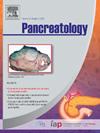病变周围分支管扩张作为MRCP鉴别高级别PanIN与低级别PanIN的标志。
IF 2.7
2区 医学
Q2 GASTROENTEROLOGY & HEPATOLOGY
引用次数: 0
摘要
背景/目的:胰腺癌(PC)通常在晚期诊断,预后较差。早期发现高级别胰腺上皮内瘤变(HG-PanIN),一种0期病变,有可能显著改善患者的预后。本研究旨在确定磁共振胆管造影(MRCP)和磁共振成像(MRI)的特异性影像学表现,以区分HG-PanIN和低级别PanIN (LG-PanIN)。方法:本多中心回顾性研究纳入57例病理证实的PanIN患者(41例HG-PanIN, 16例LG-PanIN)。MRCP和MRI图像由两位经验丰富的腹部放射科医生独立审查。计算敏感性、特异性、诊断准确性和观察者间一致性(kappa (κ)系数)。多因素logistic回归分析确定HG-PanIN的独立预测因子。结果:在MRCP上,病灶周围分支胰管(BPD)扩张成为区分HG-PanIN的有希望的成像标记,并且观察者之间存在大量一致性(κ = 0.64)。胰腺实质萎缩(PPA)也表现出诊断潜力,但受重复性较低(κ = 0.23)的限制。多变量分析发现,病灶周围BPD扩张(OR 24.62;95% ci 2.66-227.86;p < 0.01)和PPA (OR 37.21;95% ci 3.97-348.92;p < 0.01)作为HG-PanIN的独立预测因子。在亚组分析中,BPD扩张联合PPA可显著提高早期病变检测的特异性。结论:MRCP上病灶周围BPD扩张是鉴别HG-PanIN的主要影像学特征,其特征是观察者之间的大量一致。虽然MRI上的PPA是另一个重要的独立预测指标,但其较低的观察者间一致性值得谨慎。这些发现强调了MRCP和MRI在无创评估疑似PanIN中的诊断价值。本文章由计算机程序翻译,如有差异,请以英文原文为准。

Perilesional branch duct dilation as a hallmark MRCP feature for differentiating high-grade PanIN from low-grade PanIN
Background/Objectives
Pancreatic cancer (PC) is frequently diagnosed at an advanced stage with a poor prognosis. Early detection of high-grade pancreatic intraepithelial neoplasia (HG-PanIN), a stage 0 lesion, has the potential to significantly improve patient outcomes. This study aimed to identify specific imaging findings on magnetic resonance cholangiopancreatography (MRCP) and magnetic resonance imaging (MRI) that distinguish HG-PanIN from low-grade PanIN (LG-PanIN).
Methods
This multicenter retrospective study included 57 patients with pathologically confirmed PanIN (41 HG-PanIN, 16 LG-PanIN). MRCP and MRI images were independently reviewed by two experienced abdominal radiologists. Sensitivity, specificity, diagnostic accuracy, and interobserver agreement (kappa (κ) coefficient) were calculated. Multivariate logistic regression analysis identified independent predictors of HG-PanIN.
Results
On MRCP, perilesional branch pancreatic duct (BPD) dilation emerged as a promising imaging marker for distinguishing HG-PanIN, alongside substantial interobserver agreement (κ = 0.64). Pancreatic parenchymal atrophy (PPA) also exhibited diagnostic potential but were limited by lower reproducibility (κ = 0.23). Multivariate analysis identified both perilesional BPD dilation (OR 24.62; 95 % CI 2.66–227.86; p < 0.01) and PPA (OR 37.21; 95 % CI 3.97–348.92; p < 0.01) as independent predictors of HG-PanIN. In subgroup analyses, combining BPD dilation with PPA significantly enhanced specificity for early lesion detection.
Conclusions
Perilesional BPD dilation on MRCP is a primary imaging feature for differentiating HG-PanIN, characterized by substantial interobserver agreement. While PPA on MRI is another important independent predictor, its lower interobserver agreement warrants caution. These findings highlight the diagnostic value of utilizing both MRCP and MRI in the noninvasive evaluation of suspected PanIN.
求助全文
通过发布文献求助,成功后即可免费获取论文全文。
去求助
来源期刊

Pancreatology
医学-胃肠肝病学
CiteScore
7.20
自引率
5.60%
发文量
194
审稿时长
44 days
期刊介绍:
Pancreatology is the official journal of the International Association of Pancreatology (IAP), the European Pancreatic Club (EPC) and several national societies and study groups around the world. Dedicated to the understanding and treatment of exocrine as well as endocrine pancreatic disease, this multidisciplinary periodical publishes original basic, translational and clinical pancreatic research from a range of fields including gastroenterology, oncology, surgery, pharmacology, cellular and molecular biology as well as endocrinology, immunology and epidemiology. Readers can expect to gain new insights into pancreatic physiology and into the pathogenesis, diagnosis, therapeutic approaches and prognosis of pancreatic diseases. The journal features original articles, case reports, consensus guidelines and topical, cutting edge reviews, thus representing a source of valuable, novel information for clinical and basic researchers alike.
 求助内容:
求助内容: 应助结果提醒方式:
应助结果提醒方式:


